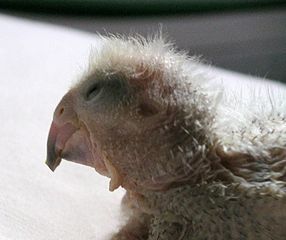 Many countries have placed an outright ban on capturing wild parrots (Mexico, most recently) and, as in the USA, require proof that birds offered for sale have been bred in captivity. Abuses occur, but rarely on the scale exhibited recently in the central African nation of the Democratic Republic of Congo (DRC). Major conservation groups are outraged at the behavior of the DRC government, which seems to be in collaboration with parrot smugglers.
Many countries have placed an outright ban on capturing wild parrots (Mexico, most recently) and, as in the USA, require proof that birds offered for sale have been bred in captivity. Abuses occur, but rarely on the scale exhibited recently in the central African nation of the Democratic Republic of Congo (DRC). Major conservation groups are outraged at the behavior of the DRC government, which seems to be in collaboration with parrot smugglers.
Smuggled Birds Seized
On September 18, 2010, 523 wild-caught African Grey Parrots (Psittacus erithacus) were confiscated at the DRC’s Kavumu Airport. The birds, on route to Singapore, were accompanied by forged CITES documents, and were in horrific condition. Twenty-nine were dead, others were tied to each other by one wing, and no food was available.
Despite having no avian facilities and operating on a shoestring budget in a politically unstable region, the Lwiro Primate Center accepted the survivors on 2 hours notice.
The World Parrot Trust appealed for help on the center’s behalf – the support of over 200 persons and organizations allowed for the hiring of 3 veterinarians and the construction of flight cages.
Parrots Set for Release, Until…
Amazingly, 460 of the parrots survived into mid-November, 2010, and 400 were deemed fit for release back into the wild.
Then, on November 22, 2010, the government of the DRC shocked the world conservation community by seizing the birds from the Lwiro Center and returning them to the dealer from whom they had been confiscated! No explanation was given the center’s staff.
The birds were packed back into their original crates, which were in flagrant violation of the standards set by the International Air Transport Association, and shipped to the dealer under CITES documents allowing for 300 birds (when in fact 490 were sent).
My Experience
I was involved in hundreds of animal confiscations during my years working at the Bronx Zoo, and am still on-call on a private basis. I can say that animals are sometimes returned to dealers here in the USA when legal loopholes allow…not, however, where abused animals are concerned, and never, as far as I know, without clear documentation of why such is occurring. While new facts may emerge, at this point the situation in the DRC seems beyond belief.
Dim Prospects for Wild African Greys

Further Reading
Please see this article for photos of the rescue effort and further details.
African Gray Parrot Conservation Issues
Natural History of the African Gray
African Grey Parrot image referenced from wikipedia and originally posted by Michael Gwyther-JonesTimneh African Grey Parrot image referenced from wikipedia and originally posted by Snowmanradio
 That Bird Blog – Bird Care and History for Pet Birds
That Bird Blog – Bird Care and History for Pet Birds



